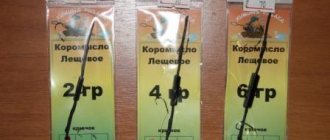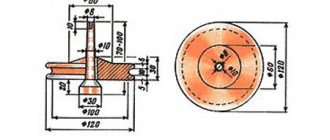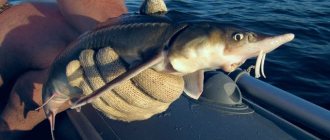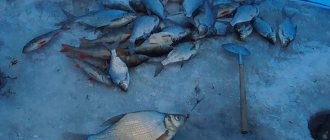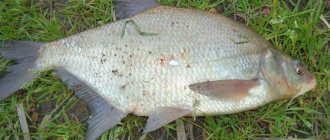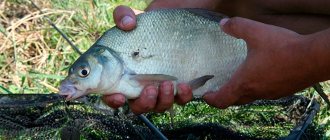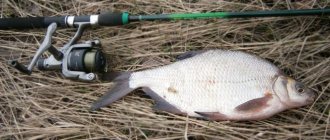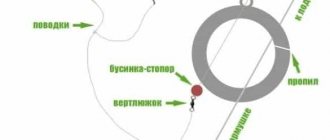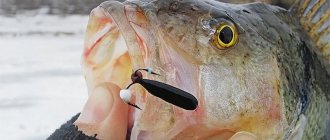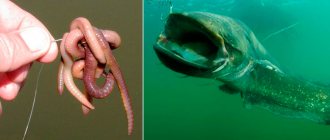Fishing in winter, as a rule, is not as rich in large specimens as in summer.
Basically, in the catch of winter fishing enthusiasts you can find the ubiquitous perch, and even then, mostly small ones. If you purposefully go fishing for bream in winter, you can catch quite large specimens, weighing up to 2 kg. Unfortunately, if you fish with a regular jig, then such a result is unlikely to be achieved. In order for large fish to bite, fishermen resort to some tricks, using more advanced equipment. A rocker is a simple but effective rig for catching bream in winter. If you use it, you can actually experience a number of advantages:
- You can fish with a rocker on a muddy bottom, when other types of equipment easily sink into it.
- The rocker actually unloads the gear.
- Large and rather cautious fish are caught on the rocker.
The effectiveness of fishing depends on many factors, but not only on correctly assembled gear. It is equally important to choose a catchable place, feed it and use an interesting and catchy bait.
Tackle elements
Properly equipping the gear is one of the main tasks. Only after solving it can you go winter fishing, which is characterized by some features:
- Rod . A rod for winter fishing is fundamentally different from a rod for summer fishing. As a rule, this is a short rod, with a comfortable light handle, a whip and a nod, as well as a stand on short legs. The “filly” or “balalaika” type fishing rod is very popular. For making a nod, lavsan is better suited as the most sensitive material that is not afraid of frost.
- Fishing line . As the main fishing line, it is better to use monofilament fishing line with a diameter of 0.14-0.16 mm. Many people point to the use of wicker, but this is a misconception, since in the cold it instantly “woodens” and freezes.
- To load the tackle , lead pellets or strips of lead are used. The weight of the load depends on the depth of the fishing spot and the magnitude of the current.
ROCKER FOR FISHING BREAM IN WINTER. SIMPLE AND CATCHABLE TACKLE.
Choosing a suitable location
The most suitable places for catching bream in winter are:
- Upper edges of wintering pits;
- “Bream tables” of reservoirs are areas with a constant depth of at least 4-5 meters and a flat bottom;
- Bottom anomalies in the middle of great depths - plateaus, “navels”;
- Channel ditches within wide and deep reaches;
- Slope ledges (“steps”);
- Pools and pits under steep yars;
- The deep channel part of the reservoir.
Recommended reading: Common pike perch
You can also very successfully catch bream in winter in places where warm waste water from thermal power plants flows into reservoirs and lakes.
The degree of drift of the equipment by the current is controlled using a sinker located below the suspension. Thus, in reservoirs, lakes and other bodies of water with stagnant water, rocker arms with a weight weighing up to 4 g are used. In weak and medium flows, the rocker arm is equipped with a weight weighing 6-8 g. In conditions of a fairly strong current, heavy sinkers weighing 10-12 g or more are used.
Rocker equipment
This is not a complicated piece of equipment to make, so there is no point in buying it in a store. Actually, stores exist for the especially lazy, although not everything they sell can be made at home. As for the rocker arm, there should be no problems in its manufacture. The main task of the rig is to distribute leashes with hooks on both sides of the rig. Two types of rocker arms are used, depending on the material of manufacture:
- Made of thin elastic steel wire.
- From a piece of insulation of an electrical wire.
Gear selection
For fishing, you should choose the gear that the fisherman knows best. Usually, in order to increase the likelihood of a bite, they fish from two or three holes with several fishing rods. At the same time, they use different attachments, different tackles, and different game tactics. Bream rarely catches in mid-water, so different types of gear are rarely used - they are mostly caught only from the bottom.
Float rod
The most traditional tackle for catching bream. A fishing rod is used in the form of a filly, which can be placed on the ice. When fishing for bream, a tent is often used. Finding fish at this time is not always effective, but it’s still warmer and more comfortable in a tent. Usually two to four fishing rods are installed through holes in the ice, not far from each other.
The float is used as a bite alarm. You can fish both in current and in still water. Bream still prefers to avoid places with strong currents at this time. For currents, use a rig with a sinker lying on the bottom and a side leash; for still water, a classic hanging rig with a sinker above the hook. Sometimes they use a rig with a main sinker or sub-weight lying on the bottom.
A bream bite in summer is noticed by the rise of the float and movement to the side. In winter, the float can rise during a bite if you use a feeder lying on the bottom, then it also moves to the side. This is very noticeable, even if the tackle is not very clearly set up. Still, it is recommended to use a high-quality float setting, because in this case even a careful bite will be noticeable.
Read How to catch pike with a castmaster lure
The float rod itself is not used very often. Most often it is combined with jig fishing.
Tips for choosing bait for bream
Spring baits Depending on weather conditions in the spring, bream can actively react to different baits: March: bloodworms, worms, semolina, dough. April worms, maggots, bloodworms. May peas, corn, dough, pasta, semolina, bread, boiled wheat , pearl barley. The higher the air and water temperatures, the faster the bream switches from animal baits to plant baits.
Summer baits In the summer heat, many people complain about the complete lack of bite, but this is not always true.
Correctly selected bait can attract the attention of bream even in the heat. June: worm, maggot, corn, peas, pasta. July: steamed pearl barley, maggot worm in the form of sandwiches. August: bread, pasta, corn, maggot worm. Temporary decreases in temperature indicators will entail a return of bream to animal types of bait; vegetable bait should be offered in hot weather.
Autumn baits In the autumn, bream continue to be actively caught on the feeder; groundbait and bait, as before, should work in tandem in such gear
As the temperature drops, bream will again want “meat” baits. September: earthworms and dung worms, maggots, hominy, bread, steamed cereals. October: bloodworms, worms, less often maggots. November: maggots and bloodworms, baits of plant origin will not work
It is important to understand that the bait used in crushed form must be added to the bait.
Winter baits In winter, bait for bream is very important; it is more difficult for passive fish to attract attention. Therefore, the selection of bait should be approached very carefully. December: sandwiches made from pieces of worms, bloodworms and maggots, less often boiled peas are used. January: bloodworms, worms. February: worms, bloodworms, semolina, peas
You can experiment and try using the dough as bait; at the end of February, bream can respond well to this species.
Jig tackle
Catching bream with a jig is an exciting activity. Due to the fact that you often have to fish in wintering pits, a large jig is used for bream - from 5-6 grams in weight. A large hook reach is also required in order to attach a large bait that is inaccessible to small fish. Bream is much more willing to take a large jig than other types of fish.
Under-ice feeder
The under-ice feeder is pure perversion. It can be successfully replaced by a regular feeder, which delivers food to the bottom, and a float rod or jig, which is used to fish directly from the bait spot. Due to the vertical nature of fishing, the tackle will be delivered very accurately. However, such a thing may seem interesting to fans of feeder fishing, or in some cases, when there is a high frequency of bites and a very high density of fish, they can deliver bait without losing the fishing pace, and then get the fish back. In winter, this situation rarely happens with bream.
"Yoke" made of wire
What is needed for this:
- You will need a piece of thin but elastic wire, with a diameter of 1.5 to 2 mm and a length of about 20 cm. To quickly make equipment, it is better to use a template, since this will result in almost identical “rocker arms”.
- To make a template, take a piece of wooden board and mark on it with a pencil the points where the bends are supposed to be. There should be three of them, into which nails are driven in, 3 mm thick. The length of the rocker arm is selected at 140 mm.
- The next stage is making the equipment according to the template, making loops in the places where the nails are hammered. After this, the equipment is removed from the nails and the excess wire is removed with wire cutters, and it is given the desired shape by hand.
- The next stage is equipping the rocker arm. To do this, thread a fishing line through three loops so that there is excess fishing line left on the outer loops, to which hooks No. 4 or No. 5 are tied. The distance from the loops to the hooks should be 3-4 cm, while the fishing line should move freely inside the loops.
- The “yoke” is attached to the main line using a central loop. Several pellets are attached next to the central ring for loading.
Installation with rocker arm
To make a feeder tackle with a rocker, we pass the main fishing line through a feeder, tube or sinker. We tie the end to the eye of the wire with any knot - a clinch, a palomar or a fishing self-tightening loop. It can be knitted as a separate bundle on a piece of fishing line, braid or fluorocarbon with a carabiner and swivel at the other end for attaching to the warp. You can also do this directly on the main cord, fishing line or shock leader. Accordingly, we tie leashes with hooks on the shoulders. The connection points with the base and leads can be covered with heat-shrinkable tubes. The thickness of the leashes and hooks are selected based on the size of the bait and the intended trophy. This equipment works both in still water and in currents. When fishing in the current, stickier plasticine-like bait is clogged into the feeder.
A feeder with a rocker is usually used according to the tactics of conventional bottom fishing, with the equipment installed for a long time. The bait is stuffed into the feeder and the bottom is thrown into a promising point in the reservoir until it bites. If there is no bite for a long time, we transfer it to another place. If the angler likes to fish using tempo tactics, then most likely the installation with a rocker arm will not be useful. In proper tempo feeder fishing, classic rigs with one hook are used.
Inline feeders
For installation using the inline principle for feeder equipment with a rocker arm, weighted springs and watermelons of any design are suitable. The weight of the load is selected depending on the fishing conditions so that the equipment is not carried away by the current. Both store-bought feeders and homemade options are suitable. This rig can also use method feeders and inline nets, although real fans of a pure feeder will call this approach blasphemy.
Helicopter with lever
If two hooks are not enough, you can place a third one above the feeder, on a special wire outlet or according to the principle of a feeder helicopter, on a hinge unit between two stoppers. In the case of passive fishing and installing a fishing rod for a long time, such equipment allows you to test three different attachments at once. The upper leash is also made short and made of stiff fishing line so as not to get twisted when reeling out the tackle.
On the anti-twist
Feeder installation with a rocker arm is also done on the anti-twist using the same principle. A wire structure with leashes is tied to the end of the main line. A bumper bead must be placed between the assembly and the tube. It is advisable to use the installation of a rocker arm on a feeder with an anti-twist in conditions where there are a lot of fish and they are not afraid of rough equipment. A bulky tube is also added to the wire fork. Article about installing a feeder anti-twist.
Source
"Yoke" made of insulation
This manufacturing option is simple:
- To do this, you need to have a piece of insulation from an electrical wire up to 150 mm long.
- A fishing line is pulled through the hole in the tube, to which hooks are attached on both sides of the tube. The distance from the tube to the hooks is 5-7 cm.
- The tube is crimped with a strip of lead, which will serve as a weight.
- After this, a piece of insulation with hooks is attached to the main fishing line. Alternatively, you can use a carabiner.
- If you make a “yoke” at home, you can prepare several pieces at once, with different loads and different hooks.
Rocker arm tackle for winter fishing. Manufacturing. Application.
Baits for catching bream on a rocker
Fishing in winter is characterized by the fact that the options for using bait are somewhat limited. An angler should always go fishing armed with several types of bait, both animal and plant origin. At the same time, you must always remember that fish in winter prefer animal baits, since they are higher in calories.
Bait number 1 for winter fishing is, of course, bloodworms. It also serves as the basis for preparing catchable bait. As a rule, it is bought in fishing stores. Some fishermen get it themselves, going to nearby bodies of water. They are extracted from bottom silt, taking it from the bottom of the reservoir. After filtering it through a bucket with thin holes, a bloodworm or mosquito larva (scientifically) remains in the bucket.
The mosquito larva is stored in a cool place, for example, in the refrigerator.
In addition to bloodworms, for catching bream in winter they use:
- Maggot.
- Worm.
- Caddisfly larvae.
- Burdock fly larvae.
Sometimes bream may not ignore baits of plant origin, such as:
- Dough.
- Semolina chatter.
- Bread.
- Pasta.
- Hercules.
- Steamed wheat or pearl barley.
Many people believe that the most popular vegetable bait is pearl barley. It is prepared in different ways, but the easiest way is to prepare it in a thermos. Before going fishing, you simply pour boiling water over it, and upon arrival at the reservoir you can already put it on a hook. Bream can take both hard and soft pearl barley. When the bite is active, you can offer the bream hard grains, and when it starts to sort out baits, it is better to give preference to soft grains. Barley and wheat will work better if flavored.
Nozzle or with nozzle
As such, there are no baitless types of jigs intended only for hunting bream. For the case of reelless fishing, the fisherman will have to experiment, empirically selecting the fishing tool that is suitable at one time or another. Therefore, breamers have a set of mothless baits in their winter arsenals, increasing the likelihood of choosing a workable bait. Devils and goats are actively used in bream strategies during the period of first ice and after the last ice, more often in the spring.
The overwhelming majority of reelless fish are equipped with a pair of beads, which, when animated with bait, can not only attract the fish visually, but also complement the game with a jig with a sound effect. At this time, schools of bream circle in shallow waters and are often active, without requiring additional bait or abundant complementary feeding.
Read How to choose a spoon for trout according to season and characteristics
No-nozzle devils and pellets with bloodworms
During the period of deep winter or already established ice, after the first wave of early winter bite, bream retreat to significant depths. In the middle of nowhere, a method of attaching fish for a long time while keeping the school at the fishing point is mandatory. The fish are mostly passive and are more likely to be attracted by bait with natural animal bait. As a refill, a classic attachment in the form of bloodworms is used, as well as burdock and pieces of dung worm, and occasionally maggots.
Bait and proper feeding of bream
You can prepare the bait at home yourself or use a store-bought dry mixture. In both cases there are both pros and cons. If you plan to cook it yourself, you can use some recipes. For example:
- The main ingredient is peas, which are boiled until tender and then passed through a meat grinder. Immediately after this, the pea mixture is mixed with breadcrumbs. If you add a couple of drops of anise, the effect of the bait will increase.
- The bait, which is made from a mixture of millet (500 grams), bread crumbs (600 g), rolled oats (250 g) and 150 g of crushed fried seeds, is considered universal. You can really add half a teaspoon of vanillin to it, and before lowering bloodworms or maggots into the hole.
- The simplest recipe consists of mixing 500 grams of breadcrumbs and 300 grams of semolina. Once mixed, the mixture can be used.
- In order to accurately and efficiently deliver bait to the fishing point, you will have to use a special feeder, which should open when it reaches the bottom.
How to fish in winter: ice fishing technique with a float
For successful ice fishing for bream on a rocker, you need not only to choose the right fishing spot, but also to feed the prey.
First of all, several holes are drilled and a dose of complementary food is dropped into each. In winter, it is better to use steamed cereal in half with chopped worms or maggots. After half an hour, you can start fishing.
The rocker allows you to attach two different baits at once, which helps you find out the preference of the bream at the moment. When biting, one shoulder of the rocker rises and the nod straightens. If you have a float tackle, the float will float to the surface . At this moment it is important to make the hook in time.
Equipment such as a rocker allows you to catch not only small fish in winter, but also large individuals. So we advise you to take a hook with you in case a heavy bream finds it difficult to fit into the hole when fishing.
The technique for catching bream on a rocker in summer is not much different from winter , except that it is recommended to do infrequent and leisurely retrieves. Bream readily bites on this tackle at any time of the year.
How to choose a catchable place
The effectiveness of fishing depends on the right choice of place. The choice of location depends on how much knowledge the angler has in terms of fish behavior in winter.
- With the appearance of the first, strong ice, bream can be found at depths of 2 to 3 meters. To find a place for this fish, you will have to drill more than one hole in promising places. Such places are considered to be differences in depth, entrances and exits from pits, and edges.
- With the onset of severe frosts, bream moves to areas with greater depths from 6 to 10 meters. It is in such areas, with significant depth, that you should look for bream.
- At the end of winter, less and less oxygen remains under the ice, so bream looks for areas rich in oxygen. These are places where underground springs flow, which are located in places where smaller, especially non-freezing rivers flow into.
- At night, bream can also be caught at depths of 2 to 4 meters.
Technique for catching bream in winter using a jig
The fishing technique largely depends on the activity of the fish and the shape of the jig used for fishing. The method of play is divided into two directions: with a smooth rise of the bait from the depth to the upper horizons of the water and with constant holding of the tool at the bottom and alternating throws and hits on the ground. A nod helps to track the game and the moment of bite, the rigidity of which is selected depending on the weight of the weight used.
The classic retrieve is to lower the bait to the bottom, after hitting it and a short pause, the angler makes a slow rise with short throws, alternating stops. More often, it is at stops that bream bites occur. The bait is lifted right up to the edge of the ice.
Another technique involves placing the bait on the bottom, after which it is lifted from the ground by 5–10 cm and then hit the bottom. Thus, the cycles are repeated for several minutes, tempting the bream with either a slower or faster retrieve.
As a rule, they work more actively and aggressively with rewinders. When playing with simulators with bait, the activity is reduced, making the movements less sharp and the pauses longer. The very moments of the bite are similar in symptoms - the bream, sucking up the bait, tries to immediately move away from the feeding site, changing the water horizon.
In order for the hook of the jig to fit tightly in the mouth of the bream, you must obviously work hard to complete your own arsenal, collecting a collection of baits of various shapes and weights. Diversity will help you make the right choice for the fishing conditions, thereby ensuring the future of bream fishing.
